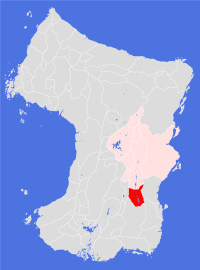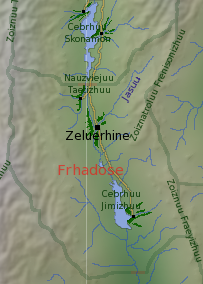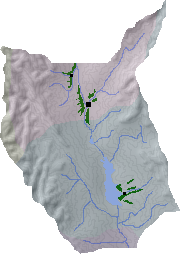Frhadose

Societal ties: Balhe
Current population: 1
Main language(s): Zeluer
Area: 185,000km²
Natural and political borders
Frhadose lies between two mountain ranges - to the west, the Zoiznuu Latsakizhuu and the southern reach of Zoiznuu Tindizhuu; to the east Zoiznuu Fraeyizhuu and Zoiznatroluu Frenisonizhuu.
The Land has control of the Taete river, and all tributaries flowing into it, between latitudes 3.5°N and 7.8°NHistory
Cebrhuu Jimizhuu was the first refuge of the (mainly lower caste) Vreski people escaping from the 'time of strife' that rocked the Vreski Empire from the mid gt660s. By gt671, refugees from the Strife had ventured deep into the heart of the continent, following the Taete river northwards.
The sustainability of these first cultivations around the lake was precarious, and many refugees died during this time. The pressure on the cultivations of the continued arrival of new refugees forced the refugees to explore the river further north. In gt686 one expedition entered the Jasuu valley and discovered the Jasuu Oasis of Type Two lifeforms that had survived there. Without doubt it was this discovery that saved the nascent Society from disaster, as novel plants well adapted to the valley climate were able to be easily transplanted and exploited.
By gt688 a new plantation - Zeluerhine - had been established below the oasis, and within 5 orbits most of the survivors had moved north. It is also at this time that the trickle of refugees dried up as the Vreski Empire entered its last, brief phase of stability. Even so, exploring the Taete valley did not halt: in gt708 pioneers from Zeluerhine established Ziguh'he Plantation, which in turn established Trinkolhe Plantation in gt725. These new cultivations were both easier to manage and maintain, and further away from the perceived danger of the Empire. By gt750 over 90 per cent of the refugees had continued northwards - easing the pressure on the Zeluerhine Plantation.
Arguably the most important export from the Land at this time was religion. The Seer Ganuete started preaching in in Zeluerhine in gt707, and had built a large following by the time of his murder in the city in gt722. The Jaesconesh sect considered the city to be a holy place, and religious tourism proved to be a lucrative industry for the locals over the next century. However, when the Taete wars broke out in gt849 - and particularly after the Jaesconesh attempted to take over the plantation in gt851 - local sentiment went against the ideologists; all the key Jaesconesh temples and monuments were destroyed by the citizens in gt854.
Despite being on the winning side in the civil war, the people of Zeluerhine decided against joining the new Land of Taete when it was established in gt879; twenty orbits later the city declared itself to be a Land, mainly to help regularise trade with the cities to the north.
The spectre of religious strife returned to the Land in gt1020 in the form of a new Seer, Mi'huede, who preached his own form of Jaeconizme outside the city walls. In early gt1023 the city authorities took action and drove Mi'huede and his followers out of the Land.

Politics and economy
The loss of religious tourism during the Taete wars was soon replaced with a new sort of tourism. The wars had triggered a national pride throughout the Taete valley, and soon people interested in visiting the legendary sites of the Balhe migration were arriving in the city. Two new settlements were established in gt888 by the city: a settlement in the north of the Land to aid trade with the other Balhe Lands, and a settlement on the eastern shore of Cebrhuu Jimizhuu specifically to cater to the tourists.
However, the most significant industry in the Land remains agriculture. Recent improvements in soil technology have seen a significant improvement in the quality and quantity of produce grown in the Plantation and settlements, and many exotic products are grown as cash crops specifically for export northwards. For instance, the southern settlement specialises in growing coffee - which commands a high price in the northern markets.
The growth in agricultural exports has also led to the Land establishing trade contacts with the Vreski Lands to the south - Frhadose is the only Balhe Land to date to engage with the Vreski Society in such a manner, as most Balhe people consider the Vreski to be evil, taboo.
Politically, the city is the Land. The city has developed a unique system of governance, where the city council is one third elected by the people, one third appointed by the main guilds and one third selected by lottery. The system seems to work, with the elected and selected council members administering their neighbourhoods as well as representing them in the council chamber. Politics tends to be a sedate affair in Frhadose.
Culture and other issues of interest
The Frhadose people are seen as a warm and welcoming folk by outsiders, though this welcome is for the most part superficial: locals tend to view outsiders as tourists rather than as potential friends. As such, most people tend to live their lives 'behind closed doors'. Family is incredibly important to the average Frhadose, and extended families tend to live near each other in the same neighbourhood.
The social differentiation between the sexes is much starker in Frhadose than in other Balhe Lands - without doubt, the women rule the nest; men are expected to move into the homes of their partners, and daughters usually live close to their mothers. Women also dominate the local markets, much of the trading infrastructure and - by extension - the monetary side of economics. Men, on the other hand, tend to look after the cultivations, the city (and tourist) infrastructure, and much of the light and heavy industry that takes place. They also appear to dominate in guild politics and - to a lesser extent, thanks to the council lottery - national politics.
The work of raising and educating children is shared by both sexes - children are practically worshipped by their families, which can lead to a teenage arrogance. Young people will generally live separately from their family for a while before settling back down into family life with their newfound partners. Antisocial behaviour by these young people is a perennial problem for the city council, and for the families of the wayward individuals.
Key natural features
The Cuskuu Fradosizhuu marks the southern end of the Taete valley, where the river joins others to flow south to the ocean. The eastern and western mountain ranges in this region are not especially high - key mountains in the western chain include Mts. Baenosuu (3,800m), Jazakuu (3,620m) and Latsakon (2,600m). The eastern mountains are lower still - key mountains include (again from north to south) Mts. Olharhuu (3,710m), Jasanuu (2,420m) and Kalastehrhuu (1,930m).
The two most important features within the Cuskuu Fradosizhuu are Cebrhuu Jimizhuu (the Lake of Rotting Corpses) in the south and the Jasuu river valley in the far north east, home of the still thriving Jasuu Oasis of Type 2 lifeforms. The Land's only city is built in the confluence of the Jasuu and Taetuu rivers.

Habitats
The northern half of the Land, including the city and the Oasis, enjoys an east central valleys habitat; the southern half, including Cebrhuu Jimizhuu, has a southern subtropical habitat.
Plantations and settlements
The only substantial cultivation in the Land is downriver from the Jasuu oasis, and along the Taete river valley where the Taete and Jasuu rivers join. Although it stretches over 130km along the rivers, and at its broadest is over 110km wide, Zeluerhine Plantation is not very productive, thus limiting the maximum size of the city - though modern soil brewing technologies are beginning to improve the situation. Two other settlements - north near the border with the Land of Taete, and on the eastern shore of Cebrhuu Jimizhuu near to the original encampments - are of more recent origin.
Key towns and cities
Rural population: 0 (0.0% of total)